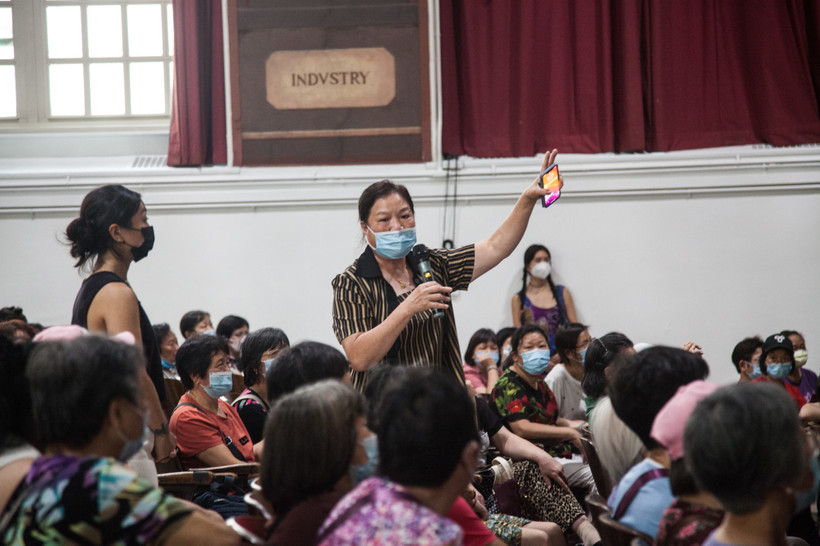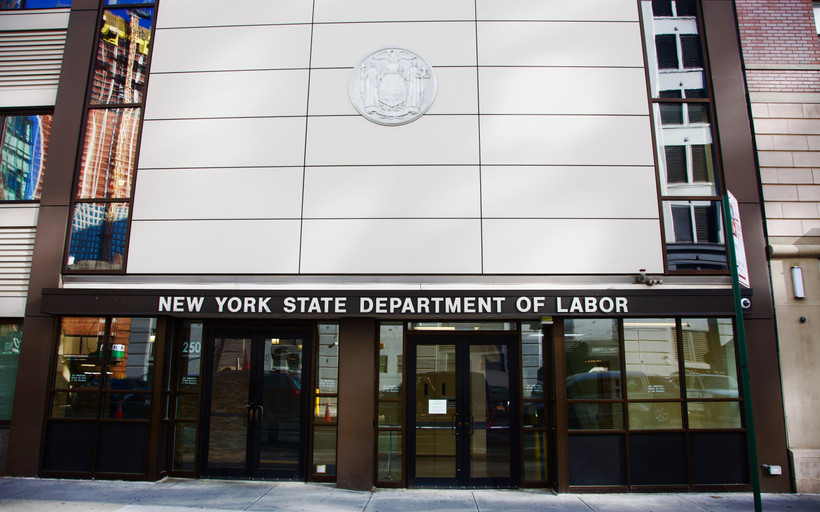Home Care Workers Battle Their Own Union on 24-Hour Shifts
1199 SIEU says it wants to end 24-hour shifts - but it has opposed city and state bills that would do so, and some question the sincerity of its objections.

Three days a week, Lai Yee Chan arrived at a stroke victim’s home for a 24-hour shift, turning him over every two hours throughout the night and helping him bathe and use the bathroom. The job, which Chan worked from 2007 until 2014, left her sleep deprived, affected her eyesight, led to joint pain, and kept her from her family.
For many of those hours, she wasn’t paid. New York state law stipulates that health aides can only be paid for 13 hours for each shift, mandating an unpaid eight-hour period for sleep and three hours for meals.
A vocal group of New York home aides has organized to ban 24-hour homecare shifts for years, and has most recently rallied in support of a New York City Council bill that would cap shifts at 12 hours and total weekly hours at 50.
But a goliath in New York health politics is blocking their path: their own union. At a heated, eight-hour hearing over the legislation earlier this month, 1199SEIU, the largest health care union in the state, came out against it. “We want to kill it. We’ll be happy with amending it if we have to settle for amending it, but we want to kill it outright,” the union’s press secretary told Documented.
After this article was published, the union told New York Focus that the press secretary’s comment did not represent the union’s position. “His one-off remark has created a lot of unfortunate confusion as to our stance. We are seeking two amendments to the bill (removing the weekly hour cap and aligning its implementation with the state budget process), not to kill it,” said vice president Bryn Lloyd-Bollard.
The union argued reform should happen on the state rather than the city level — but it doesn’t support the bill to split up 24-hour shifts that’s before the legislature either.
A version of that bill has been proposed in Albany for the past four years, and has stalled each time. The chairs of the state legislative health committees, Assemblymember Richard Gottfried and Senator Gustavo Rivera oppose the city-level bill, testifying at the hearing that the policy should pass on the state level along with $700 million to $1 billion in Medicaid funding. Without that funding, they warn, expanded worker protections could cause nonprofit homecare agencies to risk insolvency — and cost workers their jobs.
The two health committee chairs were optimistic that Governor Kathy Hochul, who has so far been more willing to expand Medicaid than her predecessor, would deliver those funds. “I do think that there is a page that has been turned and that this administration is at least open to these conversations. So it doesn’t mean that it will absolutely get done, but we can increase the pressure,” Rivera said.
But the looming question is whether 1199SEIU signs on to the state bill. And according to Epstein, negotiations with the union have hit the same roadblock that has stymied a compromise on the city bill.
The union says it supports ending 24-hour shifts. But last session, Epstein said, the union stalled the state bill because it capped homecare workers’ hours at 50 per week and would thereby prevent workers from earning overtime pay they currently rely on.
Epstein said he’s still in negotiations with the union over whether the policy would include a cap. “We haven’t come to a conclusion,” he told New York Focus.
Supporters of an hourly cap say it’s an important protection against exploitation: Home health care workers have reported that employers often pressure them to take on overtime, and many are afraid that they will risk getting fired if they refuse.
Helen Schaub, the union’s political director, told New York Focus in a statement that since a weekly cap on hours wouldn’t restrict how much aides could work for multiple employers, “it will force workers to work more hours at their second jobs to make up for lost overtime.”
Schaub also echoed Gottfried and Rivera’s argument that legislation should be tied to additional funding through the state budget.
“Absent the necessary funding to convert the 24-hour shifts into split shifts, it risks nursing home placement for thousands of homecare clients and subsequent job losses for their caregivers,” she said, adding that the union is in conversations with lawmakers and is “hopeful that these issues can be resolved in a way that protects workers and their clients.”
But some participants in the negotiations have said the union hasn’t done much to reach a compromise. Councilmember Chris Marte, the sponsor of the city-level bill, told New York Focus that while he was working out its details before introducing it, he told 1199 he was flexible on the cap and asked what the union recommended. The union never gave him an answer, he said.
After the hearing, Marte asked for union-wide data on overtime to adjust the cap. The union sent the dataset that showed that 5 to 7 percent of their home health aide members worked 24-hour shifts, but did not include information about overtime, said Marte’s chief of staff, Caitlin Kelmar.
“It’s sounding like they really don’t want a number,” Kelmar said, referring to a maximum number of hours.
She said she still hopes the union will come around. “We hope that the union is going to stand with their members on this issue,” she said.
Forced Arbitration
The union’s history on the issue has led members of the Ain’t I a Woman campaign, a coalition of groups pushing for the regulations, to conclude that the union is not negotiating in good faith and ultimately doesn’t want any version of the bill to pass.
“I think the union is lying. The real interest is to keep the 24-hour system going. The 50-hour cap is a convenient excuse,” said Sarah Ahn, a spokesperson for the campaign.
The coalition’s skepticism has its root in the union’s use of forced arbitration, a legal mechanism that often stops individual workers from seeking the full extent of stolen wage claims.
The coalition’s relationship with the union has grown increasingly tense over years of advocating for a handful of home care workers, including Chan, who sued her provider, the Chinese-American Planning Council (CPC), over stolen wages in 2015.
In 2016, in response to Chan and another 1199 member’s civil lawsuits against CPC, the union modified its collective bargaining contract with the agency so that all wage theft lawsuits would go through the union’s arbitration process. (After this article was published, the union told New York Focus that the process of negotiating an arbitration process for wage claims began in 2014, before the lawsuits.)
Legal documents that the union filed in a separate but similar lost wages suit reveal that it decided to pursue the tactic of mandatory arbitration, which would result in substantially less payment for its members than successful lawsuits, when it became clear that full reimbursement could start to bankrupt home care agencies and threaten the stability of the industry in New York state.
“Employers would not be financially able to sustain many of these claims,” the union concluded. In 2019, in order to stave off “the fragmentation and destabilization of the unionized home care sector,” it filed a class action lawsuit on behalf of its entire home care membership that would result in a one-time payout.
The union defended its use of arbitration, telling New York Focus it grants workers protections without the cost of private attorneys and with the benefit of a faster process.
Assemblymember Ron Kim’s legislative director, David Lee, who authored a blistering report documenting the union’s use of forced arbitration, said the union has effectively sided with employers over its own members.
“Their role in this situation is to say, ‘You’re not gonna get what you need, what you are legally owed, because more important than your wellbeing — than your dignity and your working conditions, your right to live a dignified life — is the stability of the home care industry,’” Lee told New York Focus.
READ MORE: Ron Kim Targets a Progressive Heavyweight in Allegations of Wage Theft
Last February, 1199 announced that they won an industry-wide $30 million forced arbitration settlement against CPC, among over 40 other agencies. The settlement figure has since increased to $40 million. The Ain’t I a Woman coalition called the settlement insulting, arguing that it’s a tiny fraction of the collective backpay that workers are owed.
“It was clear to us from the outset that using a fair, negotiated arbitration process would be far more likely to yield a positive result and greater payout for homecare workers than seeking relief in the court system,” an 1199 spokesperson wrote in a statement to New York Focus. “Our members’ $40 million dollar victory, and the dearth of compensation for the vast majority of New York’s non-union homecare workers, shows that our assessment was correct.”
The deadline for affected workers to submit a claim for their share of the money was September 27, and the union said more than 50,000 members did so.
At a rally outside 1199’s Midtown headquarters in early September, Zhifang Gu, an 1199 member and home health aide with the New York Foundation, told New York Focus that she attended a meeting about lost wages with a union representative and lawyer in February at which they told her that the forced arbitration settlement would be in her best interest. But when she realized that the settlement would not fully reimburse her for lost wages, she decided against submitting a claim.
“I was thinking that the union would help me — help us — but now I understand, they are lying,” Gu said.
The attitude of members like Gu could pose a problem for the union if the 24-hour shift bill were to pass with an overtime cap at either the city or the state level. An hourly cap could force the union to renegotiate contracts with various home care agencies — which could give disgruntled workers an opening to try to get rid of forced arbitration clauses.
The union did not respond to an inquiry about how the cap would affect its homecare contracts.
Lawmakers who opposed 24-hour shifts will now have to consider whether the city or state version is the most feasible way forward — or both. At the hearing, Councilmember Sandy Nurse asked Gottfriend whether he thought that passing the City Council would increase pressure on the state to allocate the Medicaid funding he is calling for.
“I certainly would not suggest passing the legislation with a lit fuse with the notion that that would somehow pressure the legislature into acting. It could have unpredictable and unwelcome effects,” Gottfried responded.
Correction: An earlier version of this article said that Assemblymember Harvey Epstein supported a city-level bill to end 24-hour shifts; in fact, he only supports such legislation if funding is attached. This article has also been updated to include additional comments sent by 1199SEIU after publication.






